April has been our first month of lock-down. This amounts to something like a war-time regime, very unfamiliar to the modern British population. “Do cheer up,” my wife has just interjected. “We aren’t stuck in the basement and nobody is shelling us.” True enough and there is plenty of food in the shops and the water and electricity are still on. On the other hand the pubs are shut and there is not much to do except DIY around the house. Or gardening. Other members of the family – teacher, care worker, military nurse and linesman for the power company – are designated now as essential workers, and so have daily tasks to occupy them around the region. By comparison, I’m feeling rather redundant. The other day I told my sister (similarly locked down) that if she has a great novel in her, now is the time to get it down on paper. I think she is reading the latest Hilary Mantel instead. Should I have a go for the umpteenth time at trying to read War and Peace? During the first week of lock-down, rather cruelly, the rivers came into almost perfect condition. As it is, they will lie fallow for a while. I am allowed to walk by local streams and lakes, but I am told it would be unpatriotic to fish them. Forgive me for this selfish little grizzle; it makes me feel better.
In terms of that all-important daily exercise, Nerma and I are very lucky in where we live, with 27,000 acres of rolling forested hills behind us, the Wye valley behind that, and the almost unpopulated flatlands of the Severn in front. We are both a bit old for running and cycling (if I donned lycra I would frighten the horses) but we rediscovered some old walks beside the estuary. There we can be out in the sun and the wind and stroll for miles by glistening waters without another soul in sight. The Forestry Commission has taken a sensible position, stating that their facilities including car parks are closed, but the Forest is open provided walkers keep a sensible distance apart. You don’t see many. Believe me, we feel particularly fortunate in comparison with those families trying to weather the situation in city-centre apartments.
 Forest open
Forest open 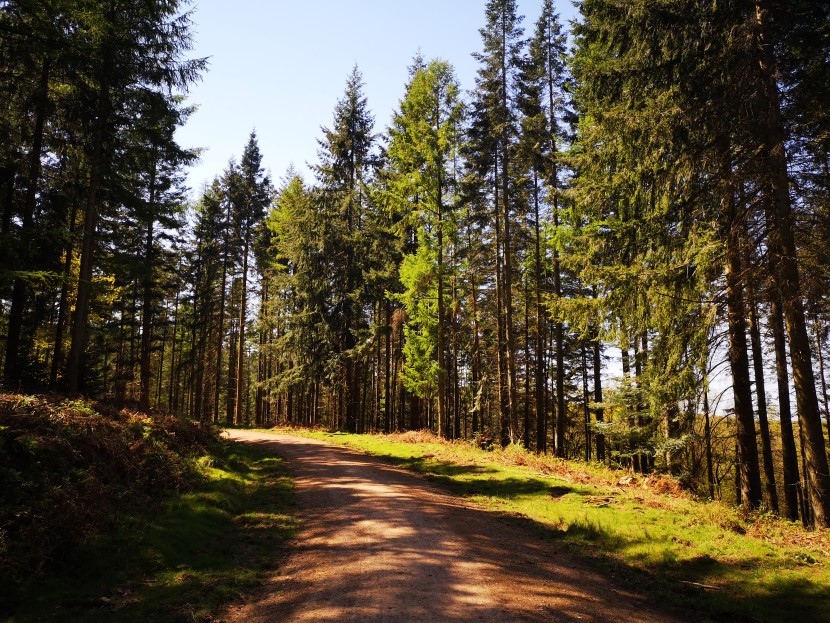 Forest roads
Forest roads 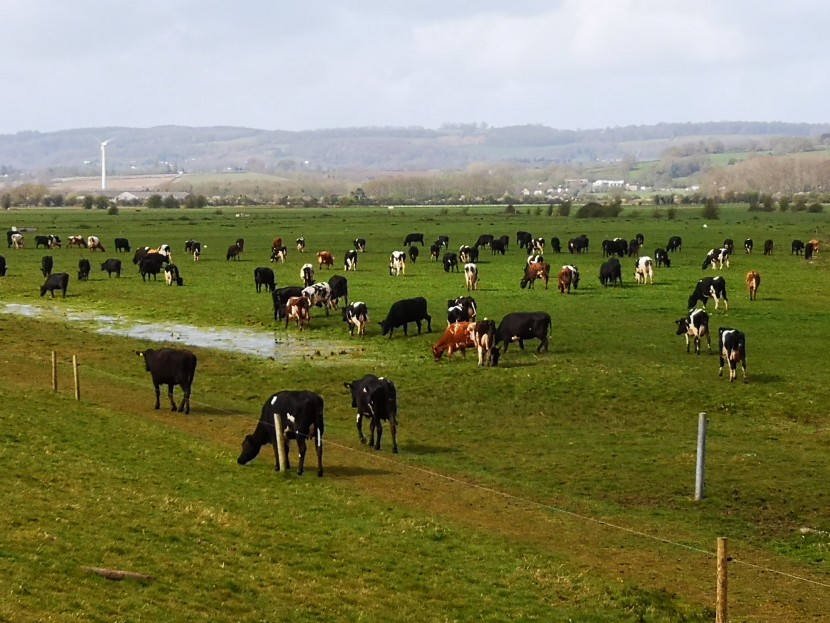 Severnside flats, my town and the Forest behind
Severnside flats, my town and the Forest behind 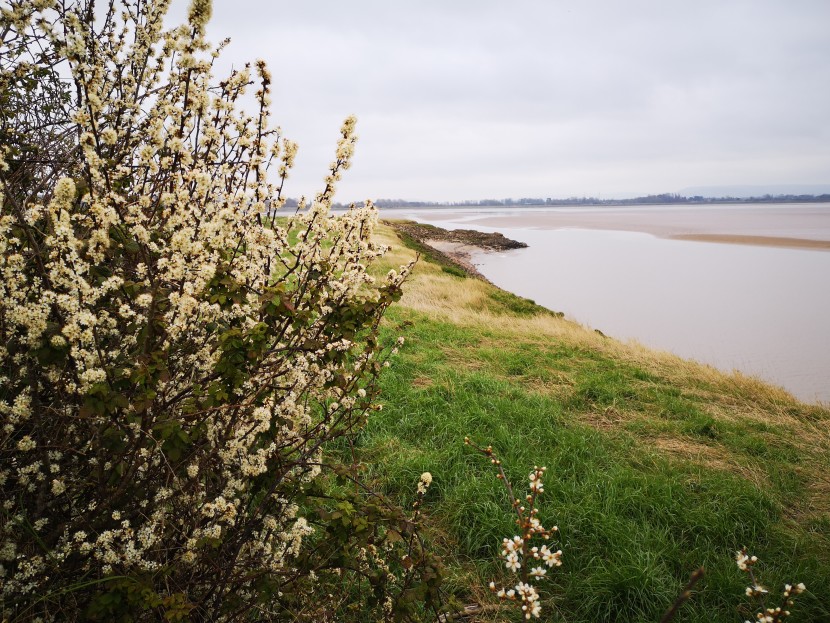 Severnside paths
Severnside paths Meanwhile the local roads, both the A48 and the road through town, are strangely empty, as if every day is an early Sunday morning. Blossom, particularly glorious this year, waves in the breeze under blue skies and the martins have arrived, but few are around to notice it. A tankful of petrol has lasted us all month. And after only a few weeks of this reduced human activity, nature seems to be coming closer. Buzzards and crows lift more reluctantly off road-kill at human approach. I saw a kite the other day, a scavenger which normally keeps clear of our wooded terrain which doesn’t suit it. Pheasants which have survived the winter shooting seem to be in every hedgerow. At the edge of the forest appear groups of deer, not too shy now even in the middle of the day, and sounders of little striped boar can be seen regularly as they root around under the trees.
The other morning I found the High Street full of sheep. Of course everybody knows we have free-range sheep in the Forest of Dean, but normally they keep out of town. Up in North Wales it is mountain goats which have descended from the Great Orme to the streets of Llandudno. Porpoises have appeared in the River Tone on the Somerset Levels. This strange silence and closer approach of nature is apparently much the same across the world. Seismologists report that the normal background vibration of vehicles and human activity has faded from their delicate instruments and air pollution levels have dropped almost everywhere. This month three cougars came padding from the hills into the deserted streets of Santiago de Chile, a city of 6 million people.
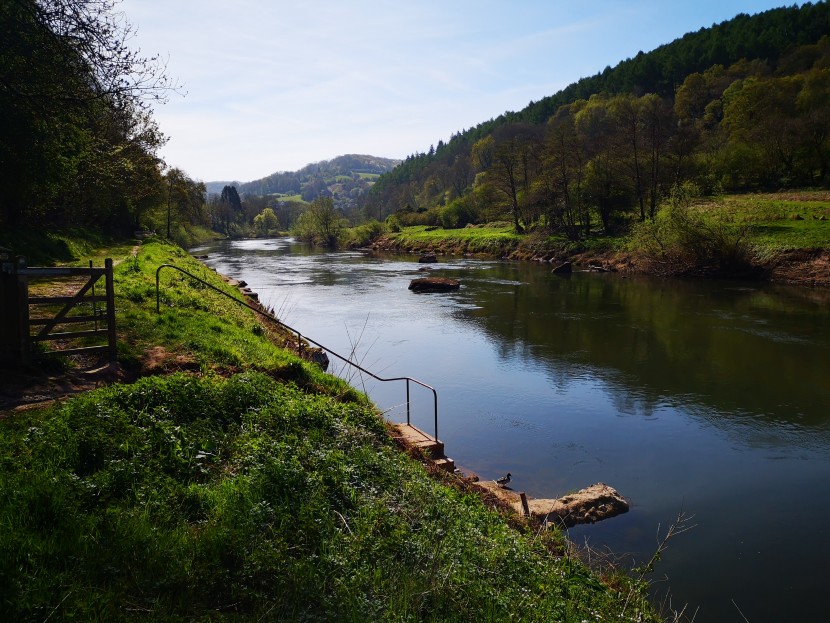 Coleman's Pool, Redbrook
Coleman's Pool, Redbrook 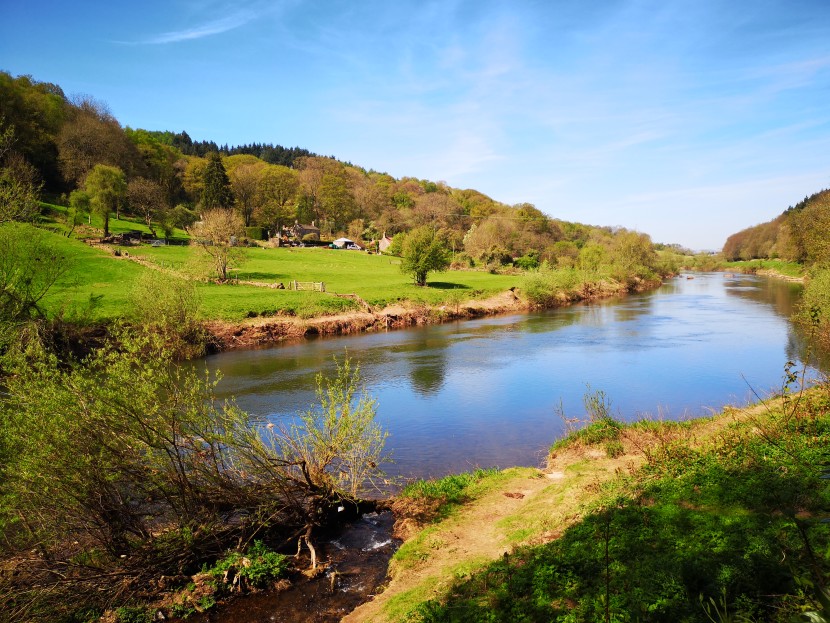 Lower Wye above Redbrook
Lower Wye above Redbrook Lacking angling – and we did lack it through most of the winter – there is another activity which gave me some pleasure recently. Normally based in Northern Ireland, our daughter was around for a bit during the winter, dividing her time between Hereford and the Infantry Training School in Brecon. As the grayling fishing was quite impossible due to long weeks of flooding – and probably because I was looking so depressed hanging around the house – she had a go at encouraging me to shoot sporting clays with her. In fact a few people have now had a go at teaching me. I only hope this won’t prove to be an impossible task, although I have certainly been enjoying it. The older one gets, the more confusing and elusive new skills seem to become. I used to do some rifle shooting at school and as I recall I was not particularly good at that. I also recall a few pot-shots with a friend’s gun at pigeons and squirrels, but that was long ago. Of course, moving targets are a very different matter from static ones. At any rate, I usually miss as many or more than I hit and I’m still at the stage of constantly needing to remind myself that it is where the target is going to be that matters, not where it is. And I have been told more than once that what I need to concentrate on for now is developing a consistent and instinctive gun mount to the shoulder, and to make it quickly, time after time.
 Clay shooter's tools
Clay shooter's tools  Sporting clays at Keeper's Lodge
Sporting clays at Keeper's Lodge Still, it was great to be out in the countryside with some sense of purpose on winter days, even while the rivers were in flood. And where I live, there are plenty of shooting opportunities, without even being tempted to send lethal shot towards fur or feather - although there are opportunities for that also. Shooting at thrown targets was originally devised to give game shooters an opportunity to practice in the off-season. Early in the 20th century at Monte Carlo live pigeons were notoriously released from baskets in front of wealthy sportsmen’s guns. Today we still talk about targets as “birds” but the various types of clay shooting have become sports in their own right. A day on the pheasants, of course, is a very expensive business, while a round of clays, including the cartridges, costs about the same as a day ticket for fishing. Fishing can be a solitary or a social sport, depending on how you approach it, but I find the clay shooting crowd distinctly “clubbable.” There are big public shoots most weekends, busy with friendly sportsmen for the most part, and for a novice like me there is the chance to watch and learn from people who are really good at the game.
As a beginner, I am forming the impression that breaking clays is a bit like playing darts, in that the more of it you do, the easier it becomes. I also note that, again rather like darts, some hefty fellows who look like they used to play Rugby in the front row of the scrum, seem to be particularly good at it. Lifting and swinging 8 pound shotguns effortlessly cradled like toys in muscular arms and shoulders, they knock down bird after bird with an air of insouciance. I may be wrong about this, but I have the impression that gaining weight does not really count against you in this sport. There is hope for us all then, those with expanded waist-lines included, and clearly there is nothing wrong with being well-grounded when you take your shots! To be fair, there are some very impressive light-weight marksmen also. Also I suppose that, unlike darts, drinking numerous pints of beer during the competition would not be such a good idea. It is true that, as with game fishing, men of my age are probably over-represented in the shooting crowd. There are plenty of grey whiskers and ruddy weather-beaten faces to be seen under tweedy caps although there are also women and young people obviously enjoying themselves. My daughter seems to feel at home.
 Target light loads
Target light loads  More difficult than it looks - the clay will hop away over the bank
More difficult than it looks - the clay will hop away over the bank The big meets take a while, because much of the time you are queuing at stands waiting to shoot, but the social side of it is very nice and watching others is a real pleasure. I try and forget about the queue behind me when it comes to my turn and do my best to concentrate on the shots. In theory sporting clays is a competitive sport and there is every opportunity to join teams or take part in matches. On the other hand, it’s perfectly possible to go quietly around the course getting your card marked and shooting only against yourself, hoping perhaps to be a little better than you were last week. In some ways it’s almost like fishing small streams, going round each corner to find a new pool and a new casting challenge. In the case of clay shooting, each new trap, if it’s well set up, poses a different challenge for the gun.
We also have a much smaller monthly meeting at the local shooting school at Trow Green on the edge of the Forest. Here about 30 attend and my acknowledged incompetence in front of this smaller audience is slightly less embarrassing. Dave and Andy must have a bit of fun setting up these traps; I do appreciate that work and skill is required and the problems they create are usually really testing. However, the other day at the school I came to a stand which I suspect was set up deliberately that morning in order to tease me personally. Imagine standing in the edge of a wood facing a steeply rising field of rough pasture. The slope you are facing is convex, so there is a horizon about 50 yards ahead and above it nothing but sky. The trap is apparently somewhere above and straight in front of you, but hidden by the swell of the hill. This will be what they call a simultaneous pair of birds. In this case you mount the gun in advance, call “pull” and somebody presses a remote control button. You would then normally hear a sort of subdued “whang” from the launcher as the clay goes into the air, but this particular machine is over the hill and far away from sight and hearing. Time seems to slow down. A couple of seconds later, in silence, two black discs like flying saucers rise simultaneously above the horizon and appear to hover. The reason for this, of course, is that the targets are in fact coming straight towards you although they look absolutely still. In my case, I sighted the gun at the left hand clay and pulled the trigger and immediately after did the same for one on the right. The Beretta made its bad-tempered “spat, spat!” and both targets flew apart. This seemed very encouraging and I reloaded two more cartridges and duly destroyed the next pair of birds to come over the hill. I missed the first of the final pair for some reason but, to cut a long story short, out of five simultaneous pairs I scored 9 clays broken.
 Shooting on my mind
Shooting on my mind  High shots with a Winchester pump
High shots with a Winchester pump  Waiting for the bird
Waiting for the bird Never in my short career had I experienced such success! Having made the gun safe, I looked over my shoulder with some fatuous and self-satisfied remark such as “I think I am getting the hang of this at last,” only to find that everybody else was killing themselves laughing. In a situation where there was no lead required at all, I had pointed and shot the gun like a rifle. In no other situation would this have been possible. On we went, to shoot on stands with difficult crossing birds, bouncing rabbits, battues and a most awkward one where looper clays lobbed from the other side of a tree fell vertically out of the sky like mortar shells. This was proper shooting at moving targets. Needless to relate, I missed almost everything.
At the moment of course, due to the Coronovirus lock-down the clay shooting activities are on hold along with most other rural pursuits. Some experiments were made in the early days of the epidemic, but even without the café selling coffee and bacon butties to a cheerful crowd, it’s difficult to see how safe separation could be achieved while participants queue to buy tickets and shoot at stands. The guns have been serviced and locked away in cabinets, while I don’t doubt that keen shooters dream at night of happier times and clay discs in the sky which always explode into smoke when the trigger is tripped.
Social media has never been busier, as we watch and wait at home, forever checking our screens as if afflicted by a nervous tic. The other morning one of our stalwart committee members of the Pontardulais club in SW Wales came out of doors to find the little Morlais brook which runs under his garden wall, normally sparkling and full of trout, was now stinking and completely black. The contents of somebody’s slurry tank was on its way to the Loughor estuary and a call to a neighbour upstream established the pollution was coming from a local farmyard. Our man took photographs and phoned the NRW where a skeleton service was in operation. He didn’t receive an incident number, but there was an undertaking to call back. Hours went past as the slurry continued to cover the stones of the stream with stinking slime. By now the internet was alive with the comments of furious anglers, most of which would be unrepeatable. The fact is that the reputation of the NRW with Welsh anglers is pretty low at the moment, given what are seen as draconian new measures on fishing for salmon and sea trout which were driven through last year. If at the same time the organisation is ineffective in policing pollution, many anglers in Wales fail to understand what the considerable licence fee they pay each year is being used for. Is it in fact no more than a tax which benefits other sections of the community and anglers not at all?
NRW did call back later the same day and stated that they were satisfied that the leak, caused by a defective valve or joint, was an accident and had been corrected. As far as they were concerned, that was the end of the affair. Our committee member would perhaps have been prepared more readily to accept that position on behalf of the pollution watch-dog, were it not for the fact that exactly the same thing had happened two years before involving the same farm. He had reported it to NRW and collected a sample of the slurry, only to be told that the sample was probably contaminated due to the beer bottle he had used! No further action on that occasion and none on this!
My question is, when does an accident become negligence? I don’t suppose that any farmer sets out deliberately to pollute rivers. But if we have a situation where the consequences are nothing more than receiving a phone call from the NRW advising that “your slurry is leaking so please put it right,” how careful are farmers likely to be? Local anglers certainly have the idea that the EA prosecutes when such incidents occur in England, so why wouldn’t the NRW prosecute when they occur in Wales? I would suggest adopting the military attitude to being careful with fire-arms: “There is no such thing as an accidental discharge, only a negligent discharge.” Today the water is running clear again below my friend’s garden terrace, but the stones and gravel are still covered with black slime which encrusts at the margins. Meanwhile, the dippers have disappeared from the stream along with the grey wagtails which were nesting on his property.
Simon Cooper of the Fishing Breaks Company which markets chalk stream fishing in various parts of the UK has an interesting article in the April issue of Trout and Salmon. As an opener he tells us he has been reading A Farmer’s Year by Rider Haggard, which was published in 1897. Rider Haggard, of course, is best known for King Solomon’s Mines, a romance inspired by his experiences in South Africa during the 1870s. Later in his life Rider Haggard returned to Norfolk where he managed farms inherited by his wife and his book on East Anglian farming is a painful illustration of the tough conditions endured by British agricultural workers at the turn of the century.
As a boy, like all other boys I read the famous King Solomon’s Mines, which was tremendously popular as an adventure novel and still being read by everybody in the years after the Second World War. “The Mines” has been filmed heaven knows how many times and Rider Haggard’s books and heroes went along with those of John Buchan, Percy F Westerman and the rest with their tales of – generally British – derring-do. Captain WE Johns kept producing his Biggles novels until the 1960s.
I must have been a little older when my grandmother told me that as a girl growing up on Ditchingham Dam, near Bungay where Norfolk borders Suffolk, she had known the Rider Haggard family very well. They were in fact the nearest neighbours. She described Rider Haggard as a “gentleman farmer,” a distinction which clearly meant something to my grandmother’s generation, if nothing much to ours. Rider Haggard’s daughter Lilias was her teenage best friend and grandmother would recount with some pride having danced as an 18 year old with Rudyard Kipling during a party at the Rider Haggards’ home. Lilias incidentally went on to edit and publish some rather wonderful collections of stories told her by old countrymen of the area. I walked by Night and The Rabbit Skin Cap are still available from Coch y Bonddu Books.
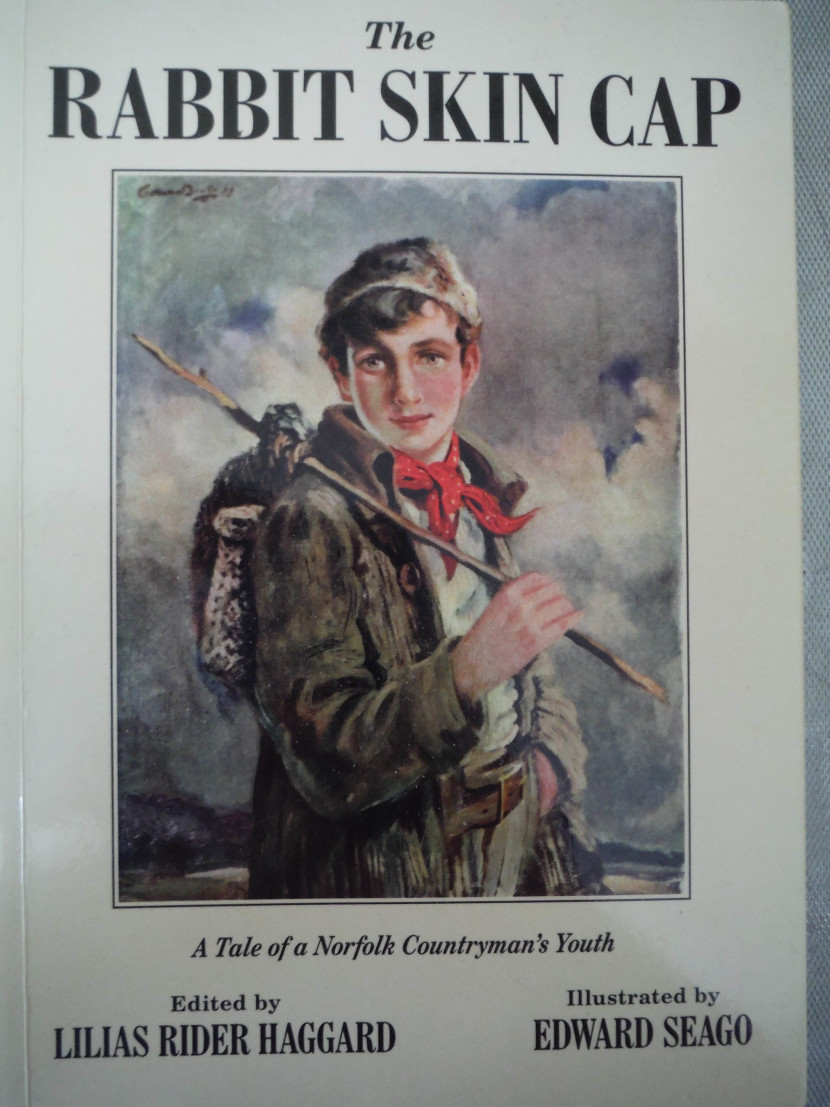 The Rabbit Skin Cap
The Rabbit Skin Cap Coming back to Simon Cooper and his reading of The Farmer’s Year, he takes particular interest in Rider Haggard’s description of the restoration of a chalk stream belonging to a friend in Hertfordshire. A lot of work is involved, including the removal of coarse fish, cleaning of the bed, carting in of gravel, sowing of water weeds – and above all restocking with young trout from a hatchery. “All these things are necessary if trout fishing is to be enjoyed in such a stream, yet so much preparation gives a certain artificiality to the final result.”
Cooper uses that last sentence to take up a stand during the rest of his article in favour of regular stocking in the case of the chalk streams at least. It’s actually quite a brave and controversial position to take, given the mood of the times. The tendency today is either to publicly support the complete re-wilding of chalk streams in a manner which might be supported by the Wild Trout Trust, or to conveniently forget to mention, as so many angling writers do, that the handsome chalk stream trout they are catching are actually stock fish. Cooper reminds us that stocking the chalk streams has been going on since the 1840s, and that the great chalk stream anglers of the past, Halford included, were all catching stock fish: “The truth is that chalk streams designed for trout fishing require stocking…. you’ll find in any wild trout chalk stream a large cohort of small fish but very few fish of what most of us would regard as of catchable size.”
Most of us don’t have the luck to fish the chalk streams, but I guess every fly fisherman has a kind of idyllic dream of them: clear water, waving ranunculus weed and those wily three pounders drifting in the current which just might be persuaded to take a dry fly. That’s the classic scene which I saw as a boy when for the first time I cycled as far as the Test valley and looked over a bridge (at Overton). Such a sight is guaranteed to generate excitement in any angler’s breast. However, just remember while you are dreaming that those great trout are almost certainly stock trout.
 Chalk streams - a man-made environment
Chalk streams - a man-made environment 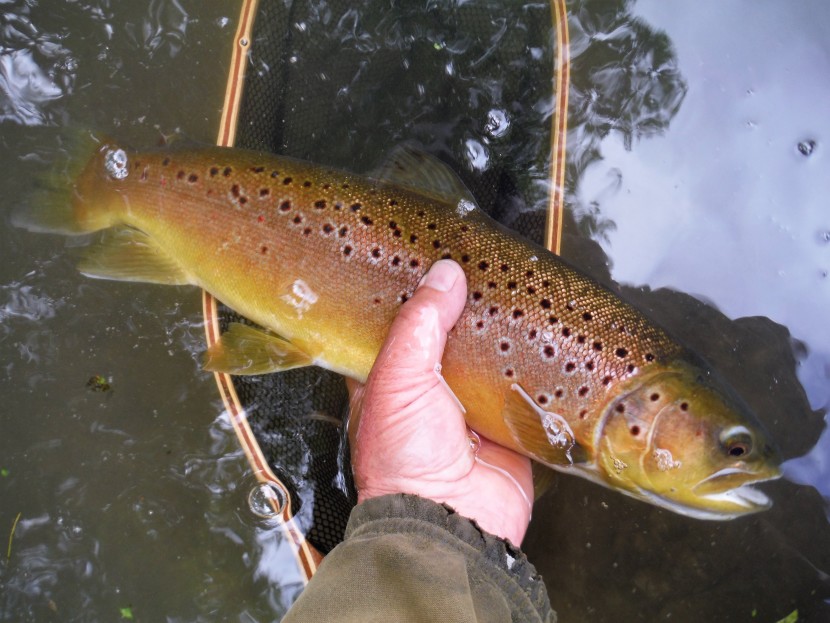 Avon trout
Avon trout 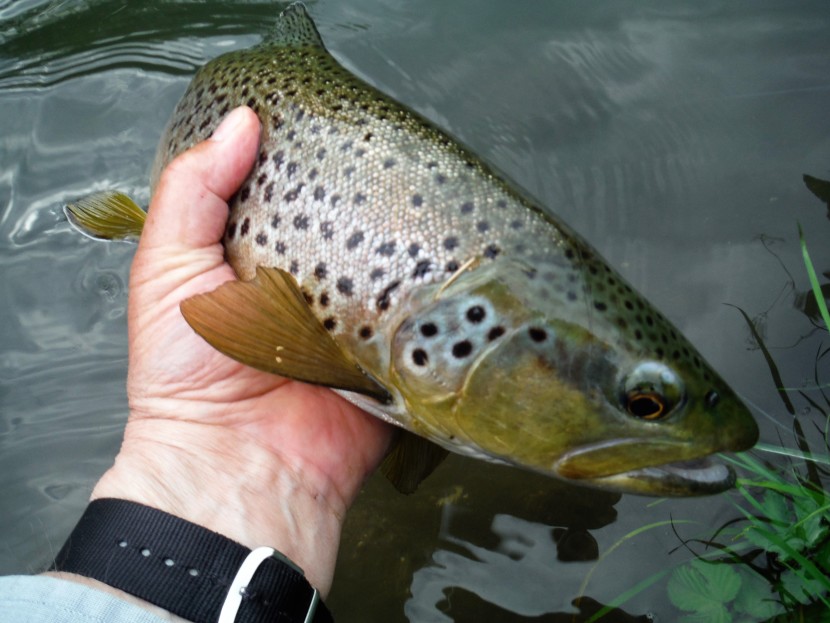 Probably a wild Avon trout
Probably a wild Avon trout There is another view of chalk stream stocking, probably best expressed by Harry Plunket Greene in Where the Bright Waters Meet. Plunket Greene was implacably against stocking after his experiences on the Bourne tributary of the Test at the beginning of the 20th century. He was, I think, the first and certainly very persuasive voice to speak out against hatchery stocking. He had known this little river when it was completely wild, apparently capable of producing remarkably large trout, and lightly fished by what seems to have been a small syndicate. He was out-voted when other members wanted to stock in order to increase the fishing potential and went on to chronicle what seem to be the classic results of putting too many trout in too small a space. If Greene can be believed, it was at the time a disaster for the little Bourne and resulted in a river full of stunted and unhealthy fish.
I find it quite hard to make my mind up about this. The chalk streams are, as I am always writing, very different from our rain-fed rivers on the Welsh borders. I am extremely fortunate to be occasionally invited to fish the Wiltshire Avon at Heale. From what I have seen I wouldn’t say the water is exactly hard-fished; often there are only two or three anglers in the day with five miles to choose from. There are long clear glides on the main river, hatch pools and some fast riffles, particularly in the carriers. Like nearly all chalk stream beats it is looked after by a keeper with weed-cutting and maintenance to weirs and banks ongoing through the year. Large trout are stocked from stew ponds on site and these form the majority of the catch although there are smaller wild trout and also grayling. The keeper and his son wage a campaign against coarse fish, particularly pike. There are still good fly hatches here and the trout, both stocked and wild, are very much prepared to rise to the surface. As a result most days are exclusively dry fly days. I understand quite well that the chalk streams are businesses, and that a significant amount of income is necessary to cover their considerable expenses. Incontrovertibly that implies pleasing anglers with exciting fishing. But if Heale were mine alone to manage and enjoy, would I give up the stocking operation and revert to wild fishing? Would it be a better fishery for that? On reflection, I don’t think so. There is an artificial element to it, of course, but chalk streams with their meadows and carriers are in any case a man-made construction. It’s all rather glorious as it is.
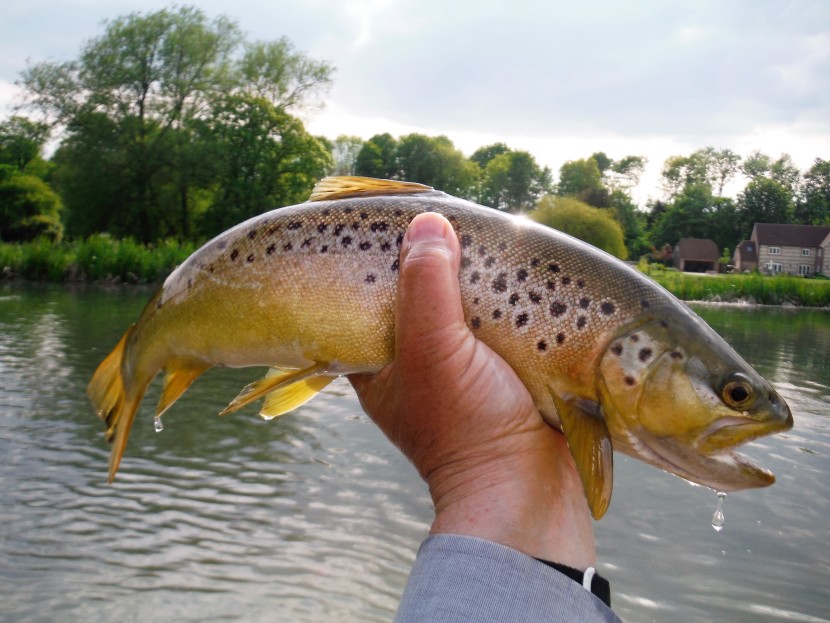 Definitely stocked but handsome
Definitely stocked but handsome 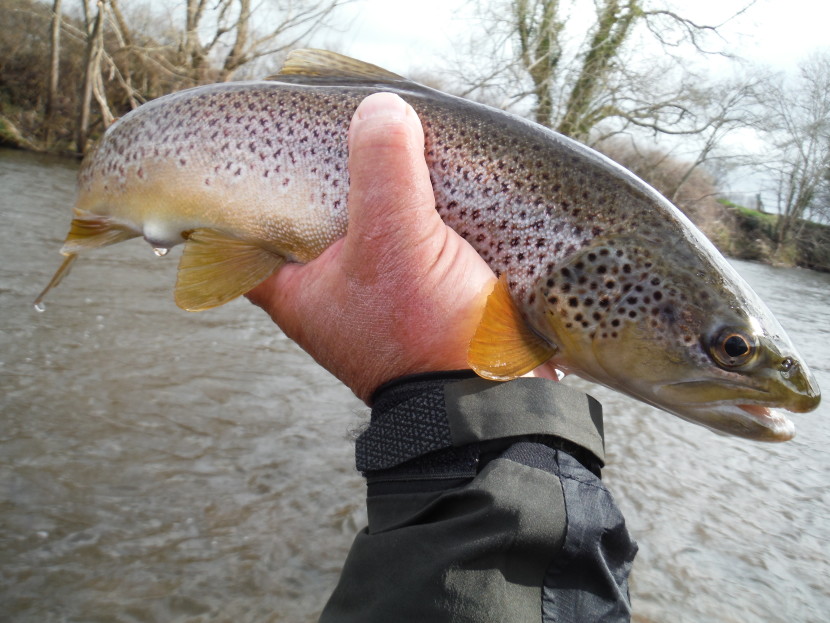 Brecon trout - possibly a grown-on stock fish
Brecon trout - possibly a grown-on stock fish 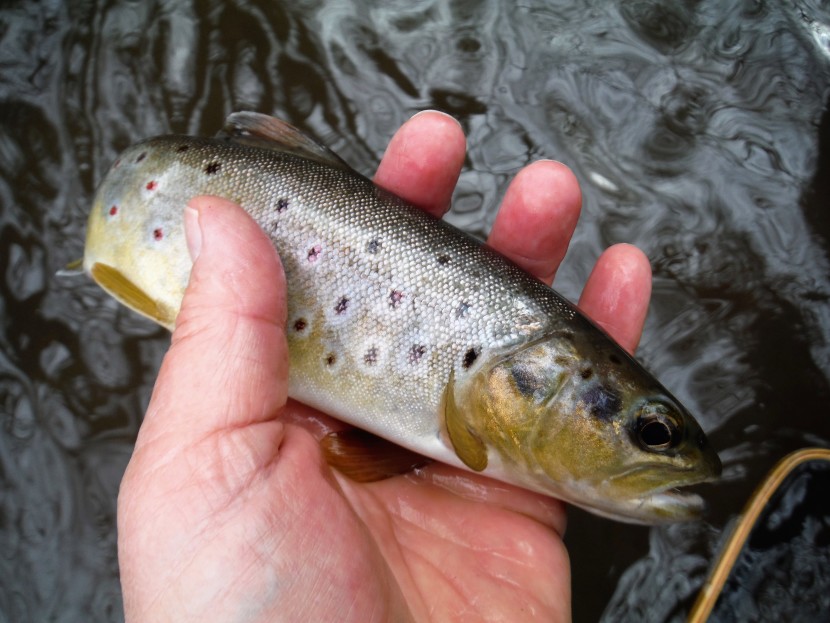 Born in the brook, there is no doubt...
Born in the brook, there is no doubt... This subject becomes more complicated when we consider our own rain fed rivers. There is less artificial stocking than there used to be, but it has been undertaken quite recently here and there – on the Lugg, Teme, Monnow and in quite a number of places on the Usk. The Taff has been stocked regularly in the past. Overwintered stock fish can grow on to look quite impressive and if they survive for a year or two it is sometimes not that easy to know the true origin of what we have caught. Damaged fins and tails are obvious enough, especially when stock fish have been poorly kept in cramped conditions. But fins repair over time and as months and then seasons go past, the difference may become less obvious. Eventually it may be a matter of comparing the patterns of body markings. Spectacular and memorable angling days can sometimes be related to migrations from the beat above or below which was stocked last year. The strong modern tendency has been to reduce or eliminate stocking in favour of habitat work to enable the natural recruitment of wild trout. We need to be realistic about the expected results however. Some streams are naturally capable of producing a better average size of trout than others, but generally the sign of a healthy river without artificial stocking is a large number of modest trout and just the occasional good one. Some people expect to create some sort of paradise where the kind of monster trout seen in New Zealand will glide through pristine waters. Be careful with your dreams; the big ones are rarer than you might think. We all know that the Usk can produce the occasional 2 pounder and larger, but your average run-of-the-mill wild fish might be 10 or 11 inches.
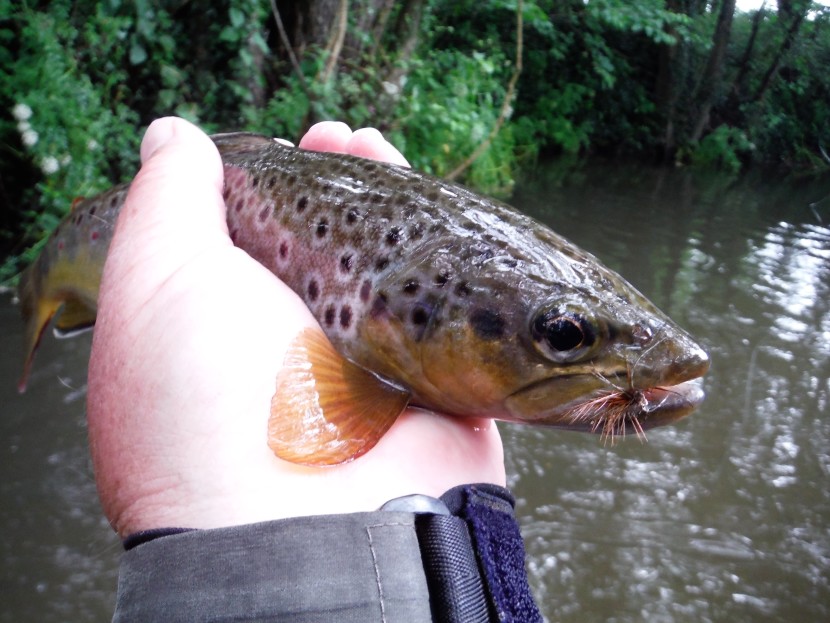 Native Forest trout
Native Forest trout 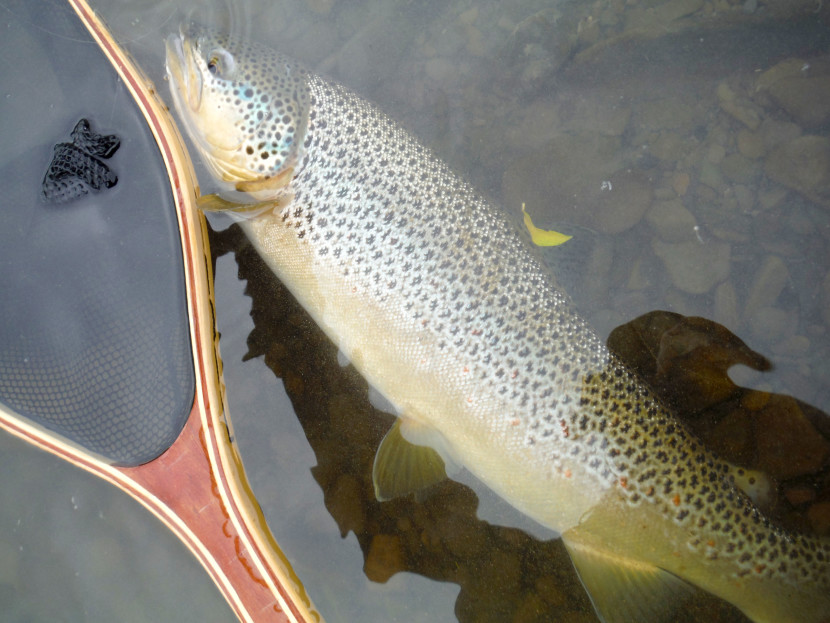 Bucknell trout
Bucknell trout  Heavy trout from the Teme
Heavy trout from the Teme A few years ago I got excited about some big fish found in the River Teme (at Bucknell) and in particular one handsome hen trout which had been rising at the head of a small pool before it fell to a Monnow Gosling. A couple of years later an article in Trout and Salmon discussed a specimen trout which, by the look of the accompanying background photograph, had been caught in the same place. I looked carefully at the close up photograph of the fish in the article and I was in no doubt; it was my old friend all right, recovered and grown on now to over 4 pounds. So look after big trout; there aren’t that many of them.
Do keep well and let’s hope we can be back to fishing before too long.
Oliver Burch
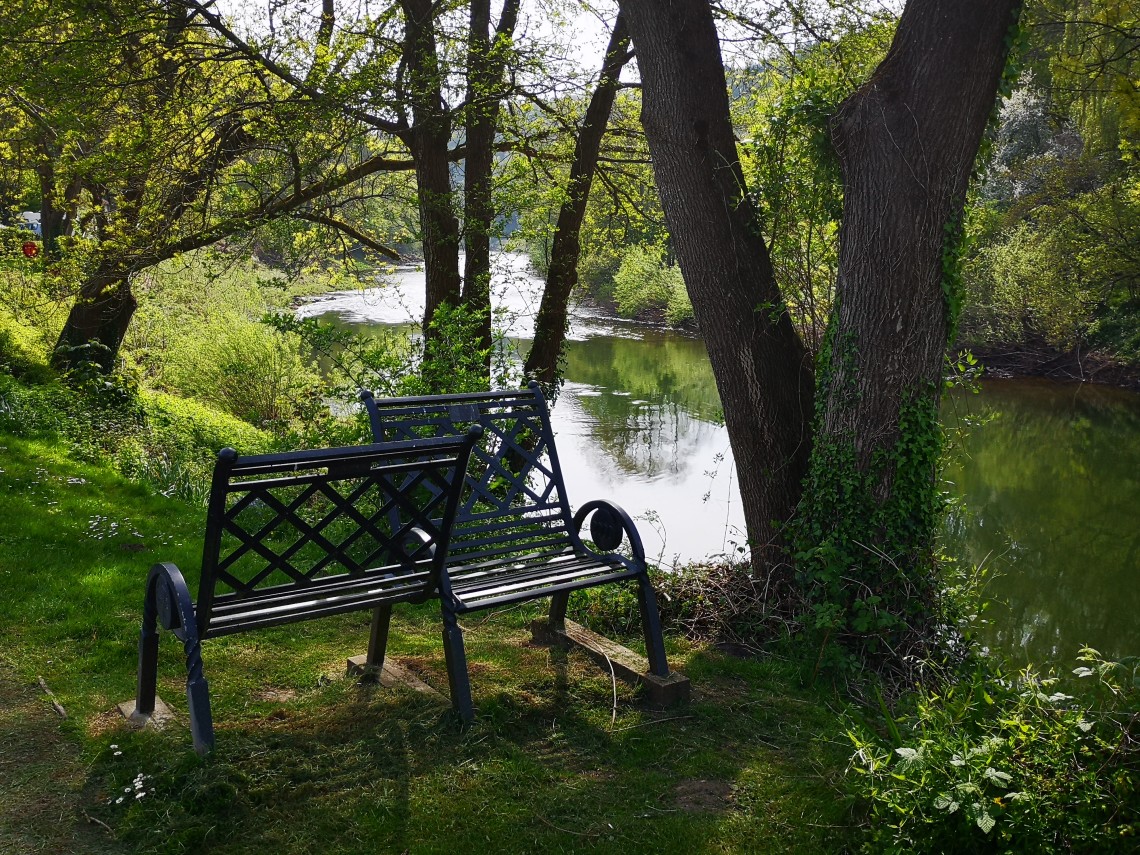 Not for use during social distancing
Not for use during social distancing